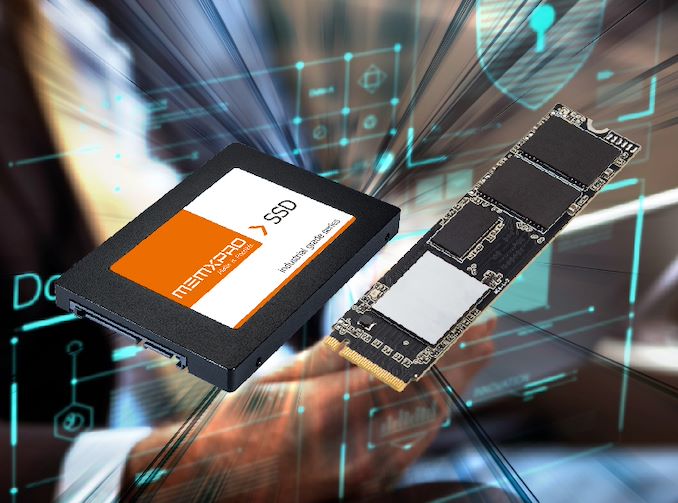What's TLC is SLC Again: MEMXPRO Introduces PC32 Full-Drive Pseudo-SLC SSDs
by Anton Shilov on February 21, 2020 12:00 PM EST
Pseudo-SLC caches for TLC-based SSDs are almost as old as TLC NAND itself, serving as a simple and practical solution to TLC's lower sustained throughput. But like all caches, pseudo-SLC caches have a finite size; and once you run over it, you're back to directly hitting the TLC. So what is a user or system builder to do if they need a drive with SLC-like performance all the time? For a while, the answer to that has been MLC drives, but with MLC slowly but surely on its way out as well, other solutions are needed. And to that end, MEMXPRO is introducing a series of new drives that go the opposite direction, embracing pseudo-SLC mode to its very core by making the entire drive pseudo-SLC.
Based on 64-layer 3D TLC memory, MEMXPRO's PC32 drives use drive-wide pseudo-SLC mode to give the drives MLC-like performance and reliability. This setup is overkill for most applications, but for use cases that require SSDs with long lifespans, and high durability – MEMXPRO's specialty – the PC32 fills an important niche.
The MEMXPRO PC32 drives in are based on the Silicon Motion SM2262EN controller as well as Micron’s B17A 64-layer 3D TLC NAND memory, which is rated for 10,000 P/E cycles. By putting the drives in pseudo-SLC mode, the manufacturer is able to increase their durability to 40,000 P/E cycles, albeit at the cost of capacity. Since TLC NAND that offers 3-bits of storage per cell is otherwise reduced to 1-bit per cell, the drives are available in capacities from just 80 GB to 320 GB. As for throughput, with the high-end controller used for the drive, MEMXPRO has rated the drives' sustained sequential read and write performance 3,250 and 2,980 MB/s respectively, which is in line with other modern SSDs featuring a PCIe 3.0 x4 interface.
Under the hood, MEMXPRO’s PC32 drives are built on PCBs with side fill and under fill protective conformal coating to enhance their reliability. Also, they are designed to ensure reliable performance within industrial temperature ranges (-40°C to +85°C), so the number of applications they can address is wide. Meanwhile, the SM2262EN controller fully supports AES 256-bit encryption with TCG OPAL 2.0 compliance, so the manufacturer can enable this functionality at request with an appropriate firmware. PC32 also supports MEMXPRO’s proprietary mSMART intelligent storage management tool to monitor drive health and lifespan status that warns owner of the drive about increased risks.
MEMXPRO will demonstrate its PC32 and other SSDs at the upcoming Embedded World 2020 trade show later this month, and will start taking orders on the drives shortly. The company has also noted their interest in developing more all-SLC drives, noting that that if the market requires higher-capacity products in a different form-factor, those SSDs could be developed as well.
Related Reading:
- Greenliant Launches EnduroSLC SSDs with Up to 250K P/E Cycles
- Enmotus MiDrive: Rethinking SLC Caching For QLC SSDs
- Toshiba Launches XL-FLASH 3D SLC NAND
- Memblaze’s PBlaze5 X26: Toshiba’s XL-Flash-Based Ultra-Low Latency SSD
- ADATA Launches microSD Cards Based on SLC NAND Memory
- Western Digital Develops Low-Latency Flash to Compete with Intel Optane
Source: MEMXPRO










39 Comments
View All Comments
AndrewJacksonZA - Friday, February 21, 2020 - link
So does "high durrability" mean that it's really, /really/ durable?Alistair - Friday, February 21, 2020 - link
Darn beat me to it :)peevee - Friday, February 21, 2020 - link
What is needed is a QLC drive which behaves like SLC up to 1/4 filled capacity, then converts some capacity to MLC up to 1/2, then to TLC up to 3/4th, and only when completely full is completely QLC.RaduR - Friday, February 21, 2020 - link
Isnt the Intel drive the one with huge SLC cache 665p . I wonder what would be the application that can fill its huge SLC cache. 280 GB of SLC for a 2 TB drive . Actually is better than this one . Probably costs almost the same and has 280 GB of SLC. Imagine that they have to use 1 TB chips for that 320GB drive so it will be close to intel 2TB QLC in BOM cost.29a - Friday, February 21, 2020 - link
I'm pretty sure that's what QLC drives do.29a - Friday, February 21, 2020 - link
Minus the MLC and TLC steps.deil - Friday, February 21, 2020 - link
but it casues a lot of rewrites if you convert back and forth.I would love to get hardware storemi solution,
like 32 GB of optane that would take all 4k or smaller stuff,
1 TB of nand for everything between 4k and let's say 4MB
and 20 TB of HDD for bigger things.
that stuff would be as epic as epyc. sssssshd
29a - Saturday, February 22, 2020 - link
I'm pretty sure it only needs converted once, reads are straight from QLC.Billy Tallis - Friday, February 21, 2020 - link
That many steps of repacking data would kill the overall write endurance. There's also just not that big a performance gap between MLC and TLC, which is why almost no products use MLC anymore. Using a MLC cache instead of SLC makes some sense (see Realtek controllers), but not having four layers of caching.peevee - Friday, February 21, 2020 - link
There isn't really that many steps, just up to 3.